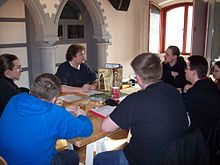
The Generic Universal RolePlaying System, or GURPS, is a tabletop role-playing game system published by Steve Jackson Games. The system is designed to run any genre using the same core mechanics. The core rules were first written by Steve Jackson and published in 1986, at a time when most such systems were story- or genre-specific. Since then, four editions have been published. The current line editor is Sean Punch.
The Storytelling System is a role-playing game system created by White Wolf, Inc. for the Chronicles of Darkness, a game world with several pen and paper games tied in. The Storytelling System is largely based on the Storyteller System, the rule set used for White Wolf's other, older game setting, the World of Darkness.
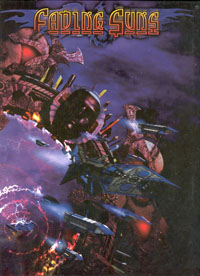
Fading Suns is a science fiction space opera role-playing game published by Holistic Design. The setting was also used for a PC game, a live action role-playing game, and for a space combat miniature game.

Midgard is a fantasy role-playing game from Germany. It was the first role-playing game published in German and the first to be created in Germany.

Torg is a cinematic cross-genre tabletop role-playing game created by Greg Gorden and Bill Slavicsek, with art by Daniel Horne. It was first published by West End Games (WEG) in 1990. Game resolution uses a single twenty-sided die, drama cards and a logarithmic results table, which later formed the basis for WEG's 1992 sci-fi RPG Shatterzone and 1994 universal RPG Masterbook. WEG produced over fifty supplements, novels and comics for the first edition. A revised and expanded core rule book was produced in 2005, with a single adventure. After WEG closed in 2010, Torg was sold to Ulisses Spiele, who, after a successful crowdfunding campaign, published a new edition called Torg: Eternity in 2018.
The metaplot is the overarching storyline that binds together events in the official continuity of a published role-playing game campaign setting, also defined as an "evolving history of a given fictional universe". Major official story events that change the world, or simply move important non-player characters from one place to another, are part of the metaplot for a game. Metaplot information is usually included within gaming products such as rule books and modules as they are released. Major events in the metaplot are often used to explain changes in the rules in between versions of the games, as was the case with the Time of Judgment in White Wolf's World of Darkness and the Time of Troubles and the Sundering for TSR's/Wizards of the Coast's Forgotten Realms. Because of events like this, many gaming groups choose to ignore the metaplot for a game entirely.

Warhammer is a tabletop miniature wargame with a medieval fantasy theme. The game was created by Bryan Ansell, Richard Halliwell, and Rick Priestley, and first published by the Games Workshop company in 1983.

Fuzion is a generic role-playing game system created by the collaboration of R. Talsorian Games and Hero Games. The rights to Fuzion are jointly held by Mike Pondsmith of R. Talsorian Games, along with Steve Peterson and Ray Greer of Hero Games. Fuzion is a combination of the Interlock System,, and the HERO system. Fuzion is an adaptable system which can be played in any genre and setting imaginable.

Fantasy Productions Medienvertriebsgesellschaft GmbH is a German publishing company based in Erkrath.

Realms of Arkania: Blade of Destiny is a role-playing video game developed by Attic Entertainment Software. It was the first game based on the German pen & paper RPG system The Dark Eye by Schmidt Spiele. The original German version of the game was released in 1992. Due to its success it was translated to English and released by Sir-Tech in 1993.

Realms of Arkania: Star Trail is a computer role-playing game by Attic Entertainment Software based on the German RPG system Das Schwarze Auge. The original German version of the game was released in 1994. Due to the success of its predecessor Realms of Arkania: Blade of Destiny, it was translated to English and released by Sir-Tech in the same year. An expansion, Speech Pack, was released in 1994 for the floppy disk version.
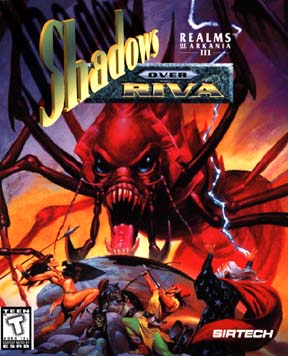
Realms of Arkania: Shadows over Riva is a role-playing video game based on the German role-playing game system Das Schwarze Auge by Attic Entertainment Software. It is the sequel to Realms of Arkania: Blade of Destiny and Realms of Arkania: Star Trail. The original German version of the game was published by TopWare Interactive in 1996. Sir-Tech released the English version in 1997.

Character creation is the process of defining a player character in a role-playing game. The result of character creation is a direct characterization that is recorded on a character sheet. This may include a representation of the character's physical, mental, psychological, and social attributes and skills in terms of the specific game's mechanics. It may also include informal descriptions of the character's physical appearance, personality, personal back-story ("background"), and possessions. Games with a fantasy setting may include traits such as race, class, or species. Character creation is the first step taken by the players in preparation for a game.

Drakensang: The Dark Eye is a 2008 role-playing video game developed by Radon Labs and published by dtp. It is the first video game in The Dark Eye universe since Attic's Northlands Trilogy from the 1990s. it was followed by the prequel River of Time, which also received an expansion Phileasson's Secret. all of them were put in a collection that is referred as the Drakensang Saga.
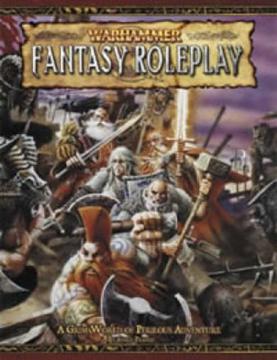
Warhammer Fantasy Roleplay or Warhammer Fantasy Role-Play is a role-playing game set in the Warhammer Fantasy setting, published by Games Workshop or its licensees.
Schmidt Spiele is a German games publisher for a wide variety of games, especially German-style board games.
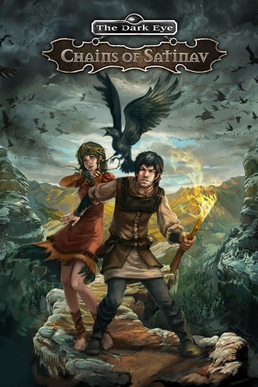
The Dark Eye: Chains of Satinav is a 2012 graphic adventure game developed by the German studio Daedalic Entertainment and published by Deep Silver. Part of The Dark Eye series, the game is set in the fictional place of Aventuria within the Kingdom of Andergast. The player controls the protagonist, Geron, who tries to save the town from disaster.
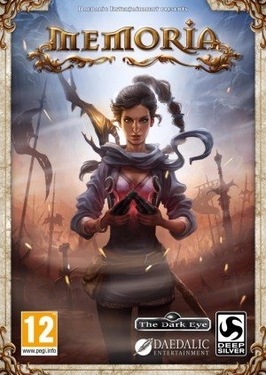
The Dark Eye: Memoria is a 2013 German point-and-click adventure game, developed and published by Daedalic Entertainment. The game is part of the video game series based on The Dark Eye, and is a direct sequel to Chains of Satinav. The game's story takes place after the events of the previous game, and focus upon Geron's quest to find a way to help his fairy Nuri recover, only to become caught in trying to unravel the mystery behind the disappearance of a heroic princess called Sadja and the quest she undertook. Following its release, the game received favourable reviews. The game was released for Windows and OS X on 30 August 2013. The game was released for Nintendo Switch, PlayStation 4, and Xbox One on 27 January 2021.

Blackguards is a 2014 tactical role-playing game for Microsoft Windows and OS X. It was developed by German game developer Daedalic Entertainment, makers of adventure games like The Whispered World, and distributed by EuroVideo. It is based on the leading German pen and paper role-playing game The Dark Eye. Due to the successful reception of the game, Daedalic Entertainment released a sequel, Blackguards 2. A definitive edition was released in 2016 for Xbox One and PlayStation 4.

Character race is a descriptor used to describe the various sapient species and beings that make up the setting in modern fantasy and science fiction. In many tabletop role-playing games and video games, players may choose to be one of these creatures when creating their player character (PC) or encounter them as a non-player character (NPC). "People" is to be taken in the broader sense, and may encompass ethnic groups, species, nationality or social groups.


